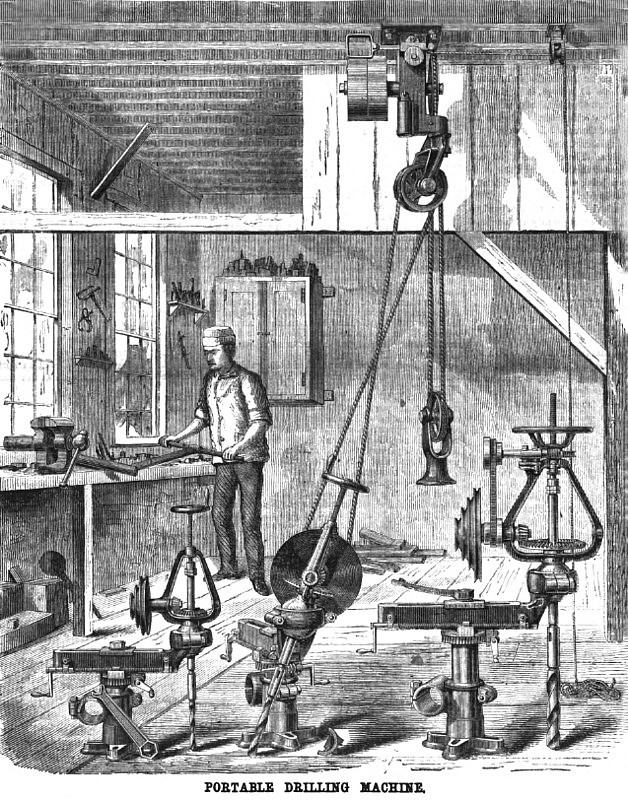|
Title: |
1872 Article-Thorne & De Haven, Portable Drilling Machine |
|
Source: |
Scientific American, V 26 #22, 25 May 1872, pg. 343 |
|
Insert Date: |
3/9/2013 7:30:17 PM |
Portable Drilling Machines.
In all machine construction, much time and labor are wasted in drilling holes by hand, for the want of a practical machine driven by power, which would do the work. Our illustration represents three sizes of portable drilling machines, manufactured by Thorne and De Haven, of Philadelphia, which fulfil the conditions required of a tool for this purpose. They can be bolted to the work to be drilled, as easily as a ratchet brace can be rigged up for hand drilling, and can be driven by power in any position, at any distance, and in any direction from the driving apparatus.
Tarred rope is used for transmitting the power, and is found to be preferable in every respect to a round leather belt.
The operation is as follows: The power is transmitted, to the fast and loose pulleys on the countershaft, by means of a flat belt from the line shaft, in the usual way. On the other end of the countershaft is a grooved pulley, which gives motion to the rope, which drives the drilling machine. The pulling side of this rope passes under an idler pulley held in a frame which rotates on a hollow stud," through which the rope passes. The rotation of t this frame permits the rope to be led in any direction to the drill. A weighted idler 1,, is hung on the slack side of the belt, maintaining the tension and permitting the distance of the drilling machine to be varied at will. A weight of only 25 pounds hung there will prevent the rope from slipping on the pulleys when drilling a two and a half-inch hole, in the solid, with an ordinary feed. When the rise and fall of this weighted idler does not give sufficient distance, additional lengths of rope can be inserted by means of the couplings used.
All the features of the machine are shown in the engraving. The height of the post can be altered to suit different lengths of drills and chucks used in the spindle. The radial arm is traveled by a screw and rotated, on the post, by a worm and tangent wheel, giving great accuracy of adjustment and permitting this adjustment without the necessity of removing the rope from the cone pulley. The frame carrying the spindle, gears, and cone pulley can be rotated so as to bring this pulley in line for the rope, in whatever position the machine may be. By removing a collar from the bottom of this frame, as shown in the central figure, the spindle can be set to an angle, with the base of the machine, in any direction. By holding the post in the clamp bearing on the side of the base, the machine will drill parallel to the base.
Both the driving apparatus and the drilling machine have been patented in this country and abroad. Any further information can be had by addressing Thorne & De Haven, 23rd and Cherry Streets, Philadelphia, Pa., or J. Austin & Co., general agents, 168 Fulton Street, New York City.
Patent #’s 113,113 & 114,229. |
|
 1872 Thorne & De Haven, Portable Drilling Machine
1872 Thorne & De Haven, Portable Drilling Machine
|
|